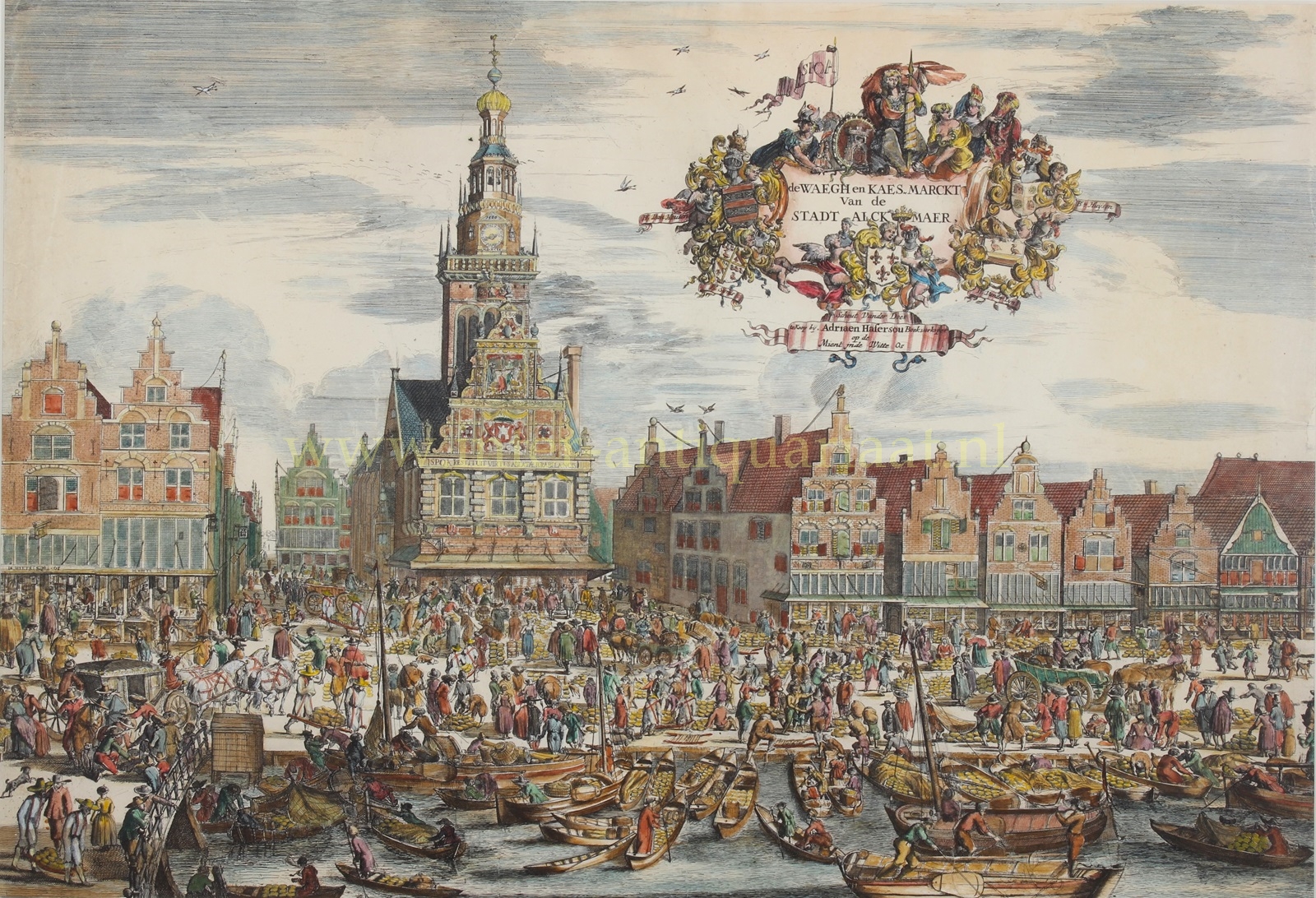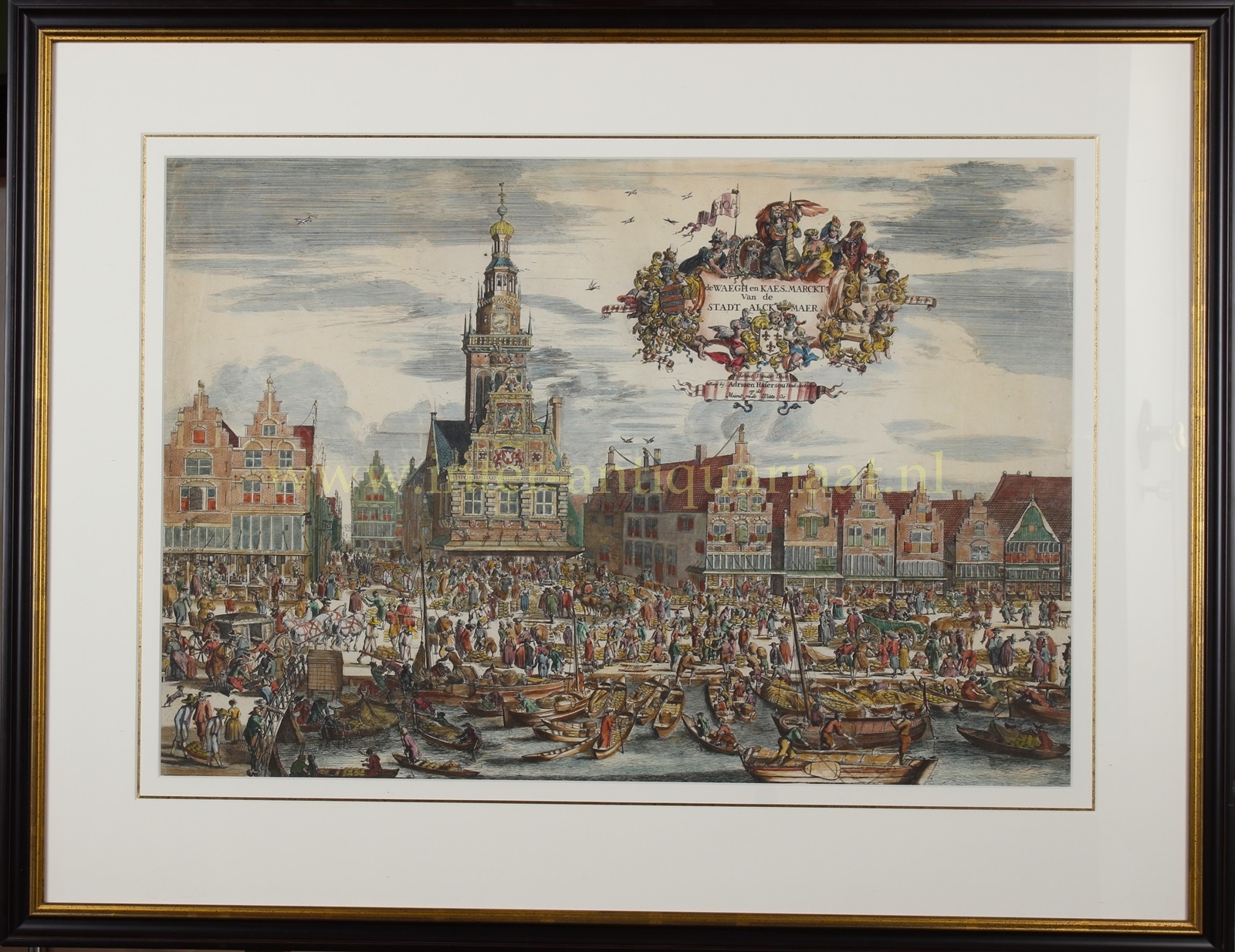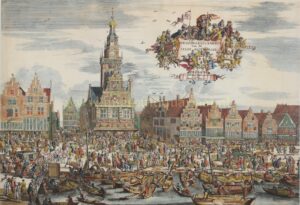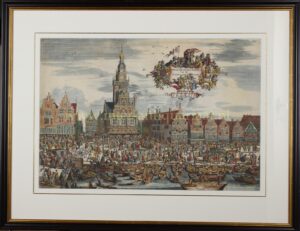Alkmaar, cheese market – Romeyn de Hooghe, 1674
“De Waegh en Kaes-Marckt Van de Stadt Alckmaer“, [The weigh house and cheese market of the city of Alkmaar] etching with engraving made by Romeyn de Hooghe in 1674, Coloured by a later hand. Size: 41 x 60 cm.
The cheese market in front of the weigh house in Alkmaar is bustling with activity. In the foreground, cheeses are being loaded and unloaded from boats. The house to the left beyond the bridge, “De Witte-Os” [the white ox] on the Mient street, belongs to bookseller Adriaen Hafersou, where this print was available for sale.
Thanks in part to the reclamation of land, including the Beemster, Heerhugowaard, and Schermer polders in the first half of the 17th century, Alkmaar grew into the most important agricultural center of Holland north of Amsterdam. Large bodies of water were transformed into fertile pasturelands. Around 1650, the city was described as “the principal source of necessities for all of Holland.” For seeds, vegetables, flax, meat, fish, and especially cheese, one had to go to Alkmaar. Cheese was traded every year from May to All Saints’ Day on Fridays and Saturdays.
Farmers came from the region with their carts and boats loaded with cheeses to the Alkmaar market. In 1566, several houses were demolished to make room for the construction of a new weigh house on the south side of the Heilige Geestgasthuis. After the Siege, in 1581, William of Orange and the States of Holland, as a reward for the heroic defense against the Spaniards during the Dutch Revolt, granted the city the income from the weigh house. The following year, construction of the weigh house began, as depicted in this etching and as we still know it today.
The weigh house did not only weigh cheese but also smoked bacon, meat, hides, and other animal products. However, the vast majority of trade in the market consisted of cheese. In 1679, 500,000 kilos of cheese were weighed in just two days. The boats with goods had fixed berths on the Mient, Voordam, and Zijdam. Porters carried the cheeses on barrows to the weigh house. Here, the cheeses were weighed. Farmers paid half a cent market fee per cheese traded to the municipality.
The main trading product was ‘sweet milk cheese’, made from whole milk. However, low-fat cheese was also traded. The dairy products from Alkmaar were known for their “excellence in purity and sharpness combined and united with an excellent pleasant taste.” The dairy products were not only tasty but also very practical. Whey, a by-product in cheese making, was used for bleaching linen.
Sweet milk cheese had a long shelf life and was therefore very suitable for export. A considerable part of Dutch export cheese was traded via Alkmaar. Most cheeses went to France, and there was also a lot of trade to the Southern Netherlands, Spain, Portugal, and Germany. This is how the spherical Edam cheese gained fame beyond the country’s borders. From the nineteenth century, cheeses were coated with a layer of paraffin for longer shelf life. This is how they got their distinctive red exterior.
Until the 1680s, there was a strong increase in the supply at the cheese market. In 1681 and 1684, the cheese market was expanded, making it the largest in the Netherlands. In the 18th century, Dutch dairy production declined. This was due to increasing operating costs because of higher polder taxes and wetting of the pastures. Additionally, the area was affected by three periods of cattle plague.
Romeyn de Hooghe (Amsterdam 1645 – Haarlem 1708) is considered the most important Dutch printmaker of the second half of the 17th century. Besides being a doctor of law and writer of books, he was a versatile artist. He is known for his many book illustrations, pamphlets, but he also etched topographical prints, maps, and city plans.
Art historian Otto Benesch called him “not only the greatest Dutch etcher of the second half of the century, but the only great artist Holland produced at the end of her classical era. He was one of the greatest illustrators of all times and comprehends within himself all the various faculties of the universal mind of the Baroque.”
The large cartouche in the upper right corner of the scene is a work of art in itself, as only Romeyn de Hooghe can create. The allegorical figures, the coat of arms of Alkmaar, and the coats of arms of four mayors and the sheriff show how important the city was.
Price: SOLD





